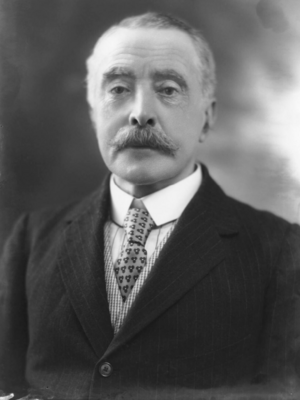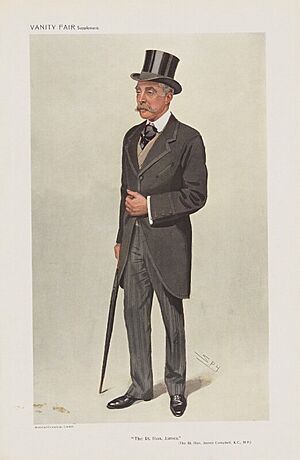James Campbell, 1st Baron Glenavy facts for kids
Quick facts for kids
The Lord Glenavy
PC
|
|
|---|---|

Campbell in 1922
|
|
| Cathaoirleach of Seanad Éireann | |
| In office 6 December 1922 – 6 December 1928 |
|
| Preceded by | New office |
| Succeeded by | Thomas Westropp Bennett |
| Lord Chancellor of Ireland | |
| In office 1918–1921 |
|
| Monarch | George V |
| Preceded by | Sir Ignatius O'Brien |
| Succeeded by | John Ross |
| Lord Chief Justice of Ireland | |
| In office 1917–1918 |
|
| Preceded by | Richard Cherry |
| Succeeded by | Thomas Molony |
| Attorney-General for Ireland | |
| In office 1916–1917 |
|
| Preceded by | John Gordon |
| Succeeded by | James O'Connor |
| In office 1905–1905 |
|
| Preceded by | John Atkinson |
| Succeeded by | Richard Cherry |
| Solicitor-General for Ireland | |
| In office 1901–1905 |
|
| Preceded by | George Wright |
| Succeeded by | Redmond Barry |
| MP for Dublin University | |
| In office 1903–1917 |
|
| Preceded by | W. E. H. Lecky |
| Succeeded by | Arthur Samuels |
| MP for Dublin St Stephen's Green | |
| In office 1898–1900 |
|
| Preceded by | William Kenny |
| Succeeded by | James McCann |
| Personal details | |
| Born | 4 April 1851 Dublin, Ireland |
| Died | 22 March 1931 (aged 79) Dublin, Ireland |
| Spouse |
Emily McCullough
(m. 1884) |
| Children | 4, including Charles and Cecil |
| Alma mater | Trinity College Dublin |
James Henry Mussen Campbell, 1st Baron Glenavy PC (Ire) (born April 4, 1851 – died March 22, 1931) was an important Irish lawyer and politician. He served in the Parliament of the United Kingdom and later in the Oireachtas of the Irish Free State, which is Ireland's parliament. He also held the high legal position of Lord Chancellor of Ireland.
Contents
Early Life and Legal Career
James Campbell was born in Dublin, Ireland. He went to school in Kingstown, which is now called Dún Laoghaire, and then studied at Trinity College Dublin. He earned his degree in 1874.
After his studies, he became a barrister in Ireland in 1878. A barrister is a lawyer who argues cases in court. By 1892, he was made an Irish Queen's Counsel. This is a special title given to experienced barristers.
Entering Politics
In 1898, Campbell was elected as a MP for St. Stephen's Green. An MP is a representative in the British Parliament. He was part of the Irish Unionist Alliance party.
He later became a barrister in England too. In 1901, he was appointed Solicitor-General for Ireland. This is a senior legal advisor to the government. In 1903, he became an MP for Dublin University.
In 1905, he was made Attorney-General for Ireland, another very important legal role. He also became an Irish Privy Counsellor, which is an advisor to the monarch. In 1916, he became the Lord Chief Justice of Ireland, a top judge.
It was quite difficult for him to get appointed as a judge. There was a lot of debate about where he should serve. However, he was widely seen as one of the best barristers in Ireland at that time.
Role During Irish Independence
In 1917, James Campbell was given the title of baronet. The next year, he became the Lord Chancellor of Ireland. This was during the Irish War of Independence, a time when Ireland was fighting for its freedom from British rule.
As the head of the Irish legal system, he was expected to support British rule. However, he was also open to the idea of the Irish Free State, which was the new independent Irish government. He was even willing to work with this new government. This practical approach sometimes upset British officials.
When he left his position in 1921, he was given the title of Baron Glenavy. This made him a member of the nobility.
First Chairman of the Irish Seanad
In 1922, the Irish Free State was formed. James Campbell was chosen to be a member of the new Free State Seanad. The Seanad is like the upper house of the Irish parliament.
On December 12, 1922, he was elected by his fellow senators to be the first Cathaoirleach. This means he was the chairperson of the Seanad. This happened during the Irish Civil War. Sadly, his family home in Kimmage, Dublin, was burned down by the anti-Treaty IRA. This was part of their actions against those who supported the new Irish state.
He was re-elected as chairman in 1925. He served until his term ended in 1928 and did not seek to be re-elected.
Shaping the Irish Courts
In January 1923, Lord Glenavy led a special committee. This committee was set up to help the Irish government create a new court system for the Irish Free State.
His ideas were put into action with the Courts of Justice Act 1924. This law largely created the Irish court system that still exists today. It replaced the old system and made sure that earlier court decisions were still valid. Lord Glenavy had some disagreements with another committee member, Hugh Kennedy, about how much the court system should change.
Lord Glenavy passed away in Dublin in 1931 and was buried in Mount Jerome Cemetery.
Family Life
James Campbell's parents were William Mussen Campbell and Delia Poole Graham. His family came from areas in County Antrim.
In 1884, he married Emily McCullough. They had three sons and one daughter. His son, Charles, later became the 2nd Baron Glenavy. Charles married the Irish artist Beatrice Elvery.
His grandson, Patrick Campbell, became a well-known writer and humorist on early television.
Arms
|


